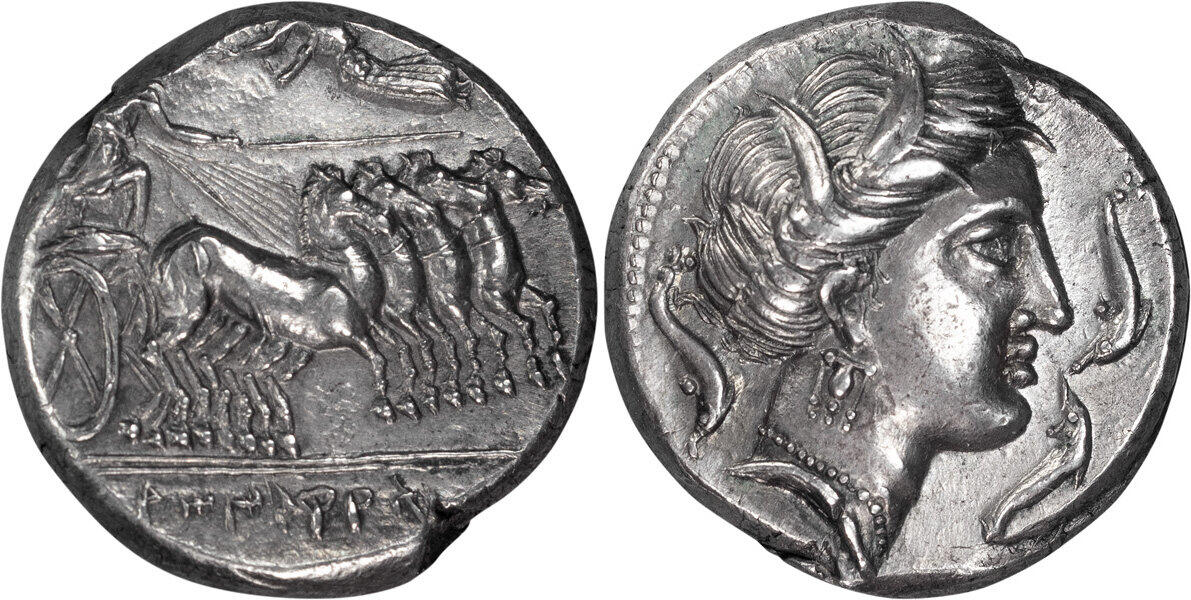H 39 - Rash Melqart - Cefalu (Carthage), silver, tetradrachms (350-300 BCE)
From SILVER
350 BCE - 300 BCE Silver 8,834 kg
Description
| ObverseInscription or printing placed on the obverse.: | "Rslmqrt" (Punic).Charioteer, holding goad in extended r. hand and reins in l., driving fast quadriga r., above, Nike flying l., about to crown charioteer with open wreath held in both hands, in exergue Punic legend "Cape of Melqart". |
| ReverseInscription or printing placed on the reverse.: | Head of Arethusa r., wearing triple-pendant earring and pearl necklace, three dolphins swimming around |
Mint and issuing power
| MintIdentifies the place of manufacture or issue of a numismatic object.: | Rash Melqart | Ancient regionAncient region.: | Sicily | Modern countryModern country: Italy | AuthorityIdentifies the issuing power. The authority can be "pretended" when the name or the portrait of X is on the coin but he/she was not the issuing power. It can also be "uncertain" when there is no mention of X on the coin but he/she was the issuing power according to the historical sources: | Carthaginian Empire |
Chronology
| FromIdentifies the initial date in a range assigned in a numismatic context. | 350 BCE | toIdentifies the final date in a range assigned in a numismatic context.. | 300 BCE | PeriodTime period of the numismatic object.: Classical and Hellenistic |
Physical description
| MetalThe physical material (usually metal) from which an object is made.: | Silver |
Median weightMedian of the weights of numismatic objects (in grams). in grams | 17.10 | DenominationTerm indicating the value of a numismatic object. Examples: tetradrachm, chalkous, denarius.: | tetradrachm |
StandardStandard.: | Attic |
Image

H 39 - Rash Melqart, silver, tetradrachm, 350-300 BC.jpg [1]
References
| Die study referencePublication of the study: | Jenkins 19711Jenkins 1971 | ||
| Coin series referenceReference to coin series study: | RQEMH2RQEMH, n° 39, HGC 23HGC 2, n° 731 | ||
Obverse dies distribution
| FrequencyFrequency of specimen in distribution. ᵖ | Number of obversesNumber of obverse dies. ᵖ (o) | % (o) | Number of coinsNumber of coins. (n) | % (n) | Die nameName(s) of the die(s). |
| 1 | 5 | 19.23 | 5 | 1.42 | 1;3;4;7;20 |
| 2 | 1 | 3.85 | 2 | 0.57 | 2 |
| 3 | 3 | 11.54 | 9 | 2.56 | 23;25;26 |
| 4 | 1 | 3.85 | 4 | 1.14 | 5 |
| 7 | 1 | 3.85 | 7 | 1.99 | 11 |
| 9 | 3 | 11.54 | 27 | 7.69 | 6;10;15 |
| 11 | 1 | 3.85 | 11 | 3.13 | 17 |
| 12 | 1 | 3.85 | 12 | 3.42 | 22 |
| 14 | 1 | 3.85 | 14 | 3.99 | 12 |
| 17 | 2 | 7.69 | 34 | 9.69 | 9;21 |
| 19 | 2 | 7.69 | 38 | 10.83 | 13;18 |
| 24 | 1 | 3.85 | 24 | 6.84 | 8 |
| 25 | 1 | 3.85 | 25 | 7.12 | 24 |
| 31 | 1 | 3.85 | 31 | 8.83 | 19 |
| 50 | 1 | 3.85 | 50 | 14.25 | 14 |
| 58 | 1 | 3.85 | 58 | 16.52 | 16 |
| Total | 26 of 26 | 100.04 | 351 of 351 | 99.99 |
Reverse dies distribution
no distribution is available
Quantification
| Number of obversesNumber of obverse dies. ᵖ (o) | 26 | Number of singletons (o1)The number of singleton coins. ᵖ | 5 |
| Number of reverse diesNumber of reverse dies. (r) | 55 | Number of coinsNumber of coins. (n) | 351 |
| Coins per obverse dieNumber of coins per obverse die. (n/o) | 13.5 | Coins per reverse dieNumber of coins per reverse die. (n/r) | 6.38 |
| Reverse per obverse ratioRatio of obverse dies divided by reverse dies. (r/o) | 2.12 | Percentage of singletons (o1)number of coins (n) divided by the number of singletons (o1) ᵖ | 19.23 % |
| Original number of dies (O) (Carter 1983 formula)The estimation of the number of coins according to Carter 1983 ᵖ | 25.83 | Coins struck if 20,000 as average productivity per dieCoins made if the average productivity for obverses (according to Carter) is 20,000. ᵖ | 516,600 |
| Original number of dies (O) (Esty 2011 formula)The estimation of the number of coins according to the singleton formula in Esty 2011 ᵖ (O) | 28.08 | Survival rate if 20,000 as average productivity per dieSurvival rate if average productivity is 20,000. ᵖ | 0.00068 |
| Coverage (o = % of O) (Esty 1984 formula)Esty 1984 - coverage (% of O) ᵖ (o = % of O) | 98.58% | Die productivity if survival rate 1/2,000Average productivity if survival rate is 1/2,000. ᵖ | 27,177.7 |
| Weight of silver (in kg) if 20,000 coins per die (O = Carter formula)Carter 1983 * Median weight * 20000 (*10 if gold or electrum) ᵖ | 8,834 kg <br /> 8,834 kg | Die productivity if survival rate 1/5,000Average productivity if survival rate is 1/5,000. ᵖ | 67,944.25 |
Remarks